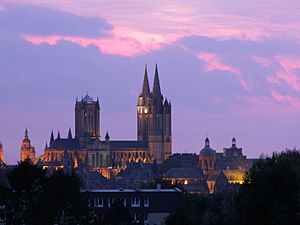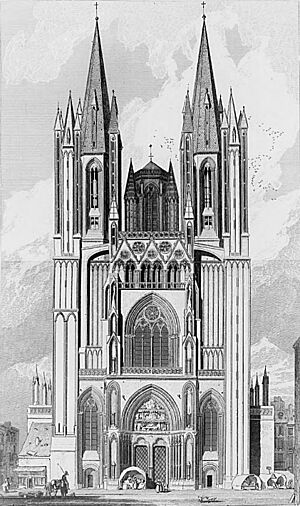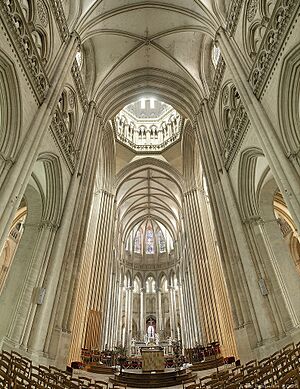Coutances Cathedral facts for kids
Quick facts for kids Coutances CathedralCathédrale Notre-Dame de Coutances |
|
|---|---|

Overview of Coutances Cathedral from the north
|
|
| Religion | |
| Affiliation | Catholic |
| Province | Diocese of Coutances |
| Region | Normandy |
| Rite | Roman Rite |
| Ecclesiastical or organizational status | Cathedral |
| Status | Active |
| Location | |
| Location | Coutances, France |
| Architecture | |
| Architectural type | church |
| Architectural style | French Gothic |
| Groundbreaking | 1210 |
| Completed | 1274 |
Coutances Cathedral is a beautiful old church in Coutances, Normandy, France. It was built in the Gothic style between 1210 and 1274. This amazing building includes parts of an even older church that stood there before.
The cathedral is the main church for the Bishop of Coutances and Avranches. It stands very tall, about 80 meters (295 feet) high. You can see it from far away, even from the island of Jersey! It's a great example of the Gothic style from Normandy, known for its long, straight, and tall lines.
Contents
History of the Cathedral
Early Beginnings and Romanesque Style
The very first church in Coutances was built around the 5th century. People believe Saint Ereptiolus, the first bishop, started it. Sadly, this church was destroyed when the Normans invaded in the 9th century.
The spot remained empty for about 150 years. Then, in the mid-11th century, a bishop named Robert began rebuilding the cathedral. He started with the main part, called the nave, in the Romanesque style. Robert passed away soon after, but Geoffrey de Montbray, the next bishop, continued the work.
Geoffrey was good friends with William, Duke of Normandy, who later became William the Conqueror. William even attended the opening of the new cathedral in 1056. Bishop Geoffrey then joined William when he conquered England. The cathedral became very rich from the money made during this conquest.
Building the Gothic Masterpiece
The Romanesque cathedral later suffered a big fire. So, in 1210, Bishop Hugues de Morville decided to build the current Gothic cathedral. He kept the same size and many parts of the old Romanesque building. You can still find parts of the older walls and towers hidden within the current cathedral.
The new Gothic cathedral was finished in 1274. It has stayed mostly the same ever since. Its two tall towers reach almost 80 meters high. The special octagonal tower in the middle, called the lantern tower, is over 57 meters tall.
Challenges and Survival
The cathedral faced some damage during the French Wars of Religion in 1562, but it was fixed quickly. In the 17th century, a screen that separated the altar from the rest of the church was removed.
During the French Revolution in 1794, the cathedral was damaged again. Statues were taken down, and some were even cut with swords. For a while, the cathedral was used as a theater, a place to store grain, and even a "Temple of Reason." Despite these losses, its main structure remained strong.
Even during World War II, when much of Coutances town was destroyed, the cathedral was mostly unharmed. It truly is a survivor!
Exploring the Cathedral's Features
Windows and Pillars
Above the main entrance, there is a modern window. It shows the people who helped build the cathedral in 1048 and 1218. In the middle, you can see Saint Ereptiole, who is thought to have built the very first church here.
In the south aisle, which is a side section, there's a pillar with carvings of medieval ladies.
The Lantern Tower
The lantern tower in the center of the cathedral is designed to bring in a lot of light. Your eyes are drawn to the circle in the middle, which represents Heaven. The square shape below represents the Earth, and the octagon represents the Resurrection.
Chapels and Art
Behind the main altar, there are six pairs of pillars holding up the roof. These are said to represent the Twelve Apostles. The windows in this area are from the 15th century.
The south ambulatory (a walkway around the altar) has the Chapel of Saint Joseph. It has a wall painting from 1381 that shows the Holy Trinity: God the Father, Christ on the Cross, and the Holy Spirit as a dove.
The Chapel of Saint Laud, also in the south ambulatory, is one of the oldest parts of the cathedral, built in the 13th century. Its stained glass window shows scenes from Saint Lo's life. One scene shows him celebrating mass with a dove (the Holy Spirit) appearing above the altar.
The north ambulatory has the Chapel of Saint Marcouf. Its window shows stories from Saint Marcouf's life. This area also holds the holy oils, called chrism. These oils are used in important church ceremonies like baptism and confirmation.
The north transept, another side section, has a 13th-century stained-glass window. It shows scenes from the lives of saints like Thomas Becket, George, and Blaise.
Floor and Organ
The floor of the north aisle has medieval tiles. Some are decorated with the fleur-de-lys, a lily symbol of the French royal family and the Virgin Mary. Other tiles show the arms of Castile next to the fleur-de-lys. The baptismal font, where baptisms take place, is also in the north aisle.
Coutances Cathedral has had an organ since before 1468. The organ you see today was built in 1728. It has four keyboards, 51 different sounds (stops), and a pedal board. The organ partly covers the large window at the west end of the church.
Above the south porch, you can see symbols of the four Evangelists: Saints Matthew, Mark, Luke, and John.
Images for kids
-
Vaults and lantern tower of Coutances Cathedral in Normandy (1210-1274)
See also
 In Spanish: Catedral de Coutances para niños
In Spanish: Catedral de Coutances para niños
- List of Gothic Cathedrals in Europe
- History of medieval Arabic and Western European domes





